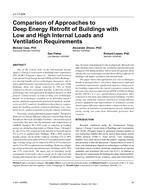
LV-17-004 — Comparison of Approaches to Deep Energy Retrofit of Buildings with Low and High Internal Loads and Ventilation Requirements
One of the critical tasks of the International Energy Agency’s Energy Conservation in Buildings and Communities (IEC ECBC) Program’s Annex 61, “Business and Technical Concepts for Deep Energy Retrofit (DER) of Public Buildings” is to develop bundles of core technologies (measures), which, when applied in major renovation projects to older (pre-1980) buildings, allow site energy reduction by 50% or better compared to the pre-renovation baseline. A short list of these technologies has been generated through an analysis of DER projects. Characteristics of some of these core technologies depend on technologies available on an individual nation’s market, minimum requirements of national standards, and lifecycle cost (LCC) analysis. In addition to these factors, requirements for building envelope-related technologies (e.g., insulation levels, windows) depend on specific climate conditions.
Previously, results published in a paper entitled “Parametric Study of Core Energy Efficiency Measures Used in Deep Energy Retrofits for Barracks and Office Facilities” showed that typical renovations that meet only the minimum code requirements of ASHRAE Standard 90.1-2010 result in reduction of building energy use (including plug loads) in Climate Zones 1 through 8 by only 8% to 16% compared to the baseline in barracks and by 8% to 22% in administrative buildings. With a DER scenario, heating energy can be further reduced, reaching 87% to 90% reduction in barracks and by 63% to 87% in administrative buildings. Cooling energy can be reduced by 60% to 67% in barracks and by 51 to 58% in administrative buildings. Reduction of lighting energy in barracks and administrative buildings will be 50% and 22%, respectively. The major part of remaining energy consumption in barracks is due to energy use by plug loads and heating of the domestic hot water (DHW). In administrative buildings, the major remaining part is due to plug loads. Barracks and office facilities have relatively low ventilation and internal loads compared with dining facilities, which raises the question about whether the core technologies used for them will be as effective in buildings with higher ventilation and internal loads.
This paper shows that application of a core technologies bundle to dining facilities, which have high process loads and ventilation requirements, significantly improves energy use in the building compared to the typical renovation scenario but does not come close to requirements of DER. A DER of a dining facility (DFAC) is a very capital-intense proposition when compared to barracks and administration buildings. Further energy use reduction requires selection of energy-efficient process equipment and improvements in ventilation systems (hood capture efficiency improvement, exhaust air heat recovery, and use of ventilation system demand control). Additional energy saving can come from dishwasher greywater heat recovery.
Citation: 2017 Winter Conference, Las Vegas, NV, Transactions, Vol 123, Pt 1
Product Details
- Published:
- 2017
- Number of Pages:
- 14
- Units of Measure:
- Dual
- File Size:
- 1 file , 7.8 MB
- Product Code(s):
- D-LV-17-004


